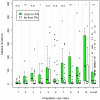Conservation efforts may increase malaria burden in the Brazilian Amazon
- PMID: 23483912
- PMCID: PMC3590219
- DOI: 10.1371/journal.pone.0057519
Conservation efforts may increase malaria burden in the Brazilian Amazon
Abstract
Background: Large-scale forest conservation projects are underway in the Brazilian Amazon but little is known regarding their public health impact. Current literature emphasizes how land clearing increases malaria incidence, leading to the conclusion that forest conservation decreases malaria burden. Yet, there is also evidence that proximity to forest fringes increases malaria incidence, which implies the opposite relationship between forest conservation and malaria. We compare the effect of these environmental factors on malaria and explore its implications.
Methods and findings: Using a large malaria dataset (~1,300,000 positive malaria tests collected over ~4.5 million km(2)), satellite imagery, permutation tests, and hierarchical Bayesian regressions, we show that greater forest cover (as a proxy for proximity to forest fringes) tends to be associated with higher malaria incidence, and that forest cover effect was 25 times greater than the land clearing effect, the often cited culprit of malaria in the region. These findings have important implications for land use/land cover (LULC) policies in the region. We find that cities close to protected areas (PA's) tend to have higher malaria incidence than cities far from PA's. Using future LULC scenarios, we show that avoiding 10% of deforestation through better governance might result in an average 2-fold increase in malaria incidence by 2050 in urban health posts.
Conclusions: Our results suggest that cost analysis of reduced carbon emissions from conservation efforts in the region should account for increased malaria morbidity, and that conservation initiatives should consider adopting malaria mitigation strategies. Coordinated actions from disparate science fields, government ministries, and global initiatives (e.g., Reduced Emissions from Deforestation and Degradation; Millenium Development Goals; Roll Back Malaria; and Global Fund to Fight AIDS, Tuberculosis and Malaria), will be required to decrease malaria toll in the region while preserving these important ecosystems.
Conflict of interest statement
Figures



 ), where values >1 indicate that the GOV scenario results in more malaria cases than the BAU scenario. Areas that were deforested in the BAU scenario but not in the GOV scenario (i.e., prevented deforestation) are depicted in the background for reference. Circles represent the cities in our original malaria dataset.
), where values >1 indicate that the GOV scenario results in more malaria cases than the BAU scenario. Areas that were deforested in the BAU scenario but not in the GOV scenario (i.e., prevented deforestation) are depicted in the background for reference. Circles represent the cities in our original malaria dataset.
 ), averaged across all cities. The red polygon represents the 95% credible interval of the average ratio
), averaged across all cities. The red polygon represents the 95% credible interval of the average ratio .
.Comment in
-
Conservation efforts and malaria in the Brazilian Amazon.Am J Trop Med Hyg. 2014 Apr;90(4):591-4. doi: 10.4269/ajtmh.13-0323. Epub 2013 Nov 25. Am J Trop Med Hyg. 2014. PMID: 24277787 Free PMC article.
-
Response to the critique by Hahn and others entitled "Conservation and malaria in the Brazilian Amazon".Am J Trop Med Hyg. 2014 Apr;90(4):595-6. doi: 10.4269/ajtmh.14-0046. Epub 2014 Mar 3. Am J Trop Med Hyg. 2014. PMID: 24591438 Free PMC article.
-
A social-ecological database to advance research on infrastructure development impacts in the Brazilian Amazon.Sci Data. 2016 Aug 30;3:160071. doi: 10.1038/sdata.2016.71. Sci Data. 2016. PMID: 27575915 Free PMC article.
References
-
- Myers N, Mittermeier RA, Mittermeier CG, Fonseca GAB, Kent J (2000) Biodiversity hotspots for conservation priorities. Nature 403: 853–858. - PubMed
-
- Tollefson J (2009) Paying to save the rainforests. Nature 460: 936–937. - PubMed
-
- Roll Back Malaria Partners (2008) The Global Malaria Action Plan for a Malaria-Free World. Geneva: World Health Organization. Available: www.rbm.who.int/gmap/.
Publication types
MeSH terms
LinkOut - more resources
Full Text Sources
Other Literature Sources
Medical

